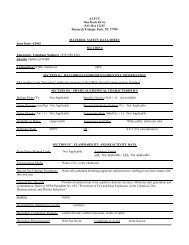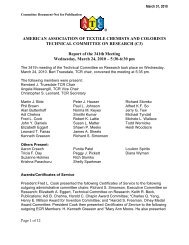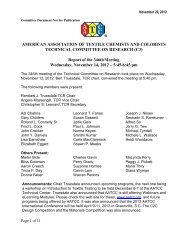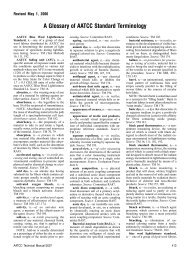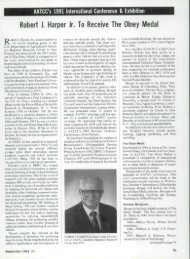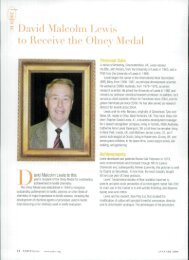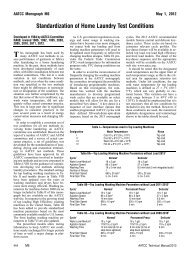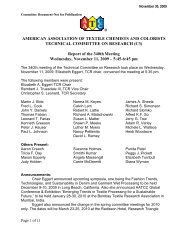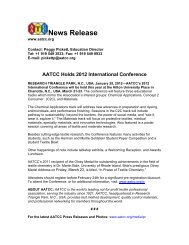A Glossary of AATCC Standard Terminology - AATCC. American ...
A Glossary of AATCC Standard Terminology - AATCC. American ...
A Glossary of AATCC Standard Terminology - AATCC. American ...
Create successful ePaper yourself
Turn your PDF publications into a flip-book with our unique Google optimized e-Paper software.
leach, n.—in textiles, an oxidizing or<br />
reducing agent used to partly or completely<br />
destroy natural or extraneous coloring<br />
matter in a textile, thereby leaving<br />
the textile lighter or whiter. Source: Committee<br />
RA93.<br />
bleach activator, n.—a bleach agent<br />
precursor, which converts a less potent<br />
bleaching species into a more powerful<br />
one. Source: TM 190.<br />
bleaching, n.—elimination <strong>of</strong> unwanted<br />
coloring matter from a textile<br />
substrate by oxidative or reductive chemical<br />
treatment. Source: TM 81, 102.<br />
bond strength, n.—in bonded and<br />
laminated fabrics, the tensile force expressed<br />
in g/cm (oz/in.) <strong>of</strong> width required<br />
to separate the component layers under<br />
specified conditions. Source: TM 136.<br />
bonded fabric, n.—a layered fabric<br />
structure wherein a face or shell fabric is<br />
joined to a backing fabric with an adhesive<br />
that does not significantly add to the<br />
thickness <strong>of</strong> the combined fabrics.<br />
NOTE 1: In this context, a thin layer <strong>of</strong><br />
foam is considered an adhesive when the<br />
cell structure is completely collapsed by a<br />
flame.<br />
NOTE 2: Normally, but not always, the<br />
backing fabric may be tricot or nonwoven.<br />
Source: TM 136.<br />
bottom surface – (B), n.—for testing<br />
purposes, the side <strong>of</strong> the specimen placed<br />
down against the lower electrical sensor<br />
which is the side <strong>of</strong> the fabric that would<br />
be the outer exposed surface <strong>of</strong> a garment<br />
when it is worn or product when it is<br />
used. Source: TM 195.<br />
breaking strength, n.—the maximum<br />
force applied to a specimen in a tensile<br />
test carried to rupture. Source: TM 111,<br />
169, 186, 192.<br />
broad bandpass radiometer, n.—a<br />
relative term applied to radiometers that<br />
have a bandpass width <strong>of</strong> more than 20<br />
nm at 50% <strong>of</strong> maximum transmittance<br />
and can be used to measure irradiance at<br />
wavelengths such as 300-400 nm or 300-<br />
800 nm. Source: TM 16.1, 16.2, 16.3,<br />
111.<br />
burnt gas fumes, n.—atmospheric oxides<br />
<strong>of</strong> nitrogen as derived from the combustion<br />
<strong>of</strong> illuminating or heating gas.<br />
Source: TM 23.<br />
bursting strength, n.—the force or<br />
pressure required to rupture a textile by<br />
distending it with a force, applied at right<br />
angles to the plane <strong>of</strong> the fabric, under<br />
specified conditions. Source: TM 111,<br />
169, 186, 192.<br />
calibration procedure, n.—a method<br />
for adjusting certain parameters in an instrument<br />
so that different instruments<br />
from the same or different manufacturers<br />
produce the same results in a test for a<br />
given property. Source: Evaluation Procedure<br />
11.<br />
carbonizing, n.—a chemical process<br />
for eliminating cellulosic matter from a<br />
mixture with animal fibers by degrading<br />
the cellulosic material to an easily friable<br />
condition. Source: Committee RA93.<br />
care instructions, n.—in textiles, a series<br />
<strong>of</strong> directions describing which care<br />
practices should refurbish a product without<br />
adverse effects and warning <strong>of</strong> those<br />
care practices expected to have a harmful<br />
effect. Source: TM 188.<br />
carpet, n.—all textile floor coverings<br />
not designated as rugs. Source: TM 121,<br />
122, 123, 138, 165, 171.<br />
carpet pile brush, n.—a hand operated<br />
brush having long, semi-rigid bristles<br />
intended specifically for erecting the<br />
pile <strong>of</strong> small areas <strong>of</strong> carpet. (see also pile<br />
lifter.) Source: TM 171.<br />
cationic dye, n.—a dye that dissociates<br />
in an acidified, aqueous solution to give a<br />
positively charged colored ion. Source:<br />
Committee RA87.<br />
cellulase enzyme, n.—an enzyme that<br />
attacks cellulose. Source: TM 191.<br />
center wavelength, n.—the specified<br />
wavelength for a bandpass filter; the<br />
wavelength midway between the half<br />
power points, for example, 340 nm ± 2<br />
nm. Source: TM 111.<br />
chelating agent, n.—in textile chemistry,<br />
a chemical capable <strong>of</strong> deactivating<br />
metal ions by formation <strong>of</strong> a water soluble<br />
complex. SYN: sequestering agent.<br />
Source: TM 149, 161, 168.<br />
chemical finish, n.—chemical material<br />
other than colorants and residual processing<br />
chemicals added to textiles to impart<br />
desired functional or aesthetic properties<br />
to the textile product. Source: TM 94.<br />
chemical finishing, n.—the process <strong>of</strong><br />
applying chemicals, other than colorants,<br />
to textiles to impart desired functional<br />
and/or aesthetic characteristics which<br />
may or may not be durable in normal use.<br />
Source: Committee RA93.<br />
chroma, n.—the proportion <strong>of</strong> spectrally<br />
pure color that expresses the degree<br />
<strong>of</strong> departure from the gray <strong>of</strong> the same<br />
lightness. Source: Evaluation Procedure<br />
9.<br />
chrome dye, n.—a mordant dye capable<br />
<strong>of</strong> forming a chelate complex with a<br />
chromium ion. Source: Committee<br />
RA87.<br />
CIE 1976 L*a*b* equation, n.—a<br />
commonly used equation which transforms<br />
CIE tristimulus values into a threedimensional<br />
opponent color space. Generally<br />
abbreviated as CIELAB. Source:<br />
TM 173.<br />
CIE chromaticity coordinates, n.—<br />
the ratio <strong>of</strong> each <strong>of</strong> the tristimulus values<br />
<strong>of</strong> a psychophysical color to the sum <strong>of</strong><br />
the tristimulus values (ASTM E 284).<br />
Source: TM 110.<br />
CIE tristimulus values, n.—amounts<br />
<strong>of</strong> three non-real reference color stimuli<br />
required to give a color match with the<br />
color stimulus considered, and defined by<br />
the CIE for the CIE 1931 standard ob-<br />
server and the CIE 1964 supplementary<br />
standard observer and for a particular illumination<br />
condition. Source: TM 110.<br />
CIE Whiteness Index (CIE WI), n.—<br />
an index predicting the apparent degree<br />
<strong>of</strong> whiteness <strong>of</strong> a material based on tristimulus<br />
values determined according to<br />
one <strong>of</strong> the CIE standard methods, proposed<br />
by the Commission Internationale<br />
de l’Éclairage (CIE). Source: Evaluation<br />
Procedure 11.<br />
clean-fiber content, n.—the amount<br />
<strong>of</strong> fiber after removal <strong>of</strong> nonfibrous content.<br />
Source: TM 20A.<br />
cleaning head, n.—a vacuum head<br />
modified with spray nozzles for cleaning<br />
solution application. Some types include<br />
a powered brush unit to facilitate wetting<br />
and soil release. Source: TM 171.<br />
cleanness, n.—in carpet soiling tests,<br />
the absence <strong>of</strong> change in appearance due<br />
to soil, specifically the degree to which<br />
the specimen approaches the original<br />
clean, unsoiled condition. (see also soil<br />
affinity.)<br />
NOTE: Cleanness is independent <strong>of</strong><br />
changes <strong>of</strong> physical structure which may<br />
be present because <strong>of</strong> exposure to traffic<br />
or action <strong>of</strong> cleaning procedures. Source:<br />
TM 121.<br />
CMC unit, n.—in color difference<br />
evaluation, a measure <strong>of</strong> acceptability expressed<br />
in terms <strong>of</strong> the boundary for the<br />
CMC acceptability ellipsoid <strong>of</strong> ∆E cmc = 1.0.<br />
NOTE: CMC is an acronym for the<br />
Colour Measurement Committee (<strong>of</strong> the<br />
Society <strong>of</strong> Dyers and Colourists) which<br />
was largely responsible for the development<br />
<strong>of</strong> the CMC (l:c) equation. Source:<br />
TM 173.<br />
coated fabrics, n.—a flexible material<br />
composed <strong>of</strong> a textile fabric and an adherent<br />
polymeric or other material applied<br />
to one or both surfaces. Source:<br />
Committee RA93.<br />
color change, n.—as used in colorfastness<br />
testing, a change in color <strong>of</strong> any<br />
kind (whether a change in hue, chroma or<br />
lightness) Source: TM 192.<br />
color change, n.—a change in color <strong>of</strong><br />
any kind whether in lightness, hue or<br />
chroma or any combination <strong>of</strong> these, discernible<br />
by comparing the test specimen<br />
with a corresponding untested specimen.<br />
Source: Evaluation Procedures 1, 7, TM<br />
16.1, 16.2, 16.3, 111, 196.<br />
color strength, n.—a measure <strong>of</strong> the<br />
ability <strong>of</strong> a dye to impart color to other<br />
materials.<br />
NOTE: Color strength is evaluated by<br />
light absorption in the visible region <strong>of</strong><br />
the spectrum. Source: TM 182.<br />
colorant, n.—a material which is applied<br />
to a substrate for the express purpose<br />
<strong>of</strong> changing the transmittance or reflectance<br />
<strong>of</strong> visible light.<br />
NOTE: Dyes, pigments, tints and optical<br />
brighteners are examples <strong>of</strong> colorants;<br />
soils are not colorants. Source: TM 140,<br />
452 <strong>AATCC</strong> Technical Manual/2013



